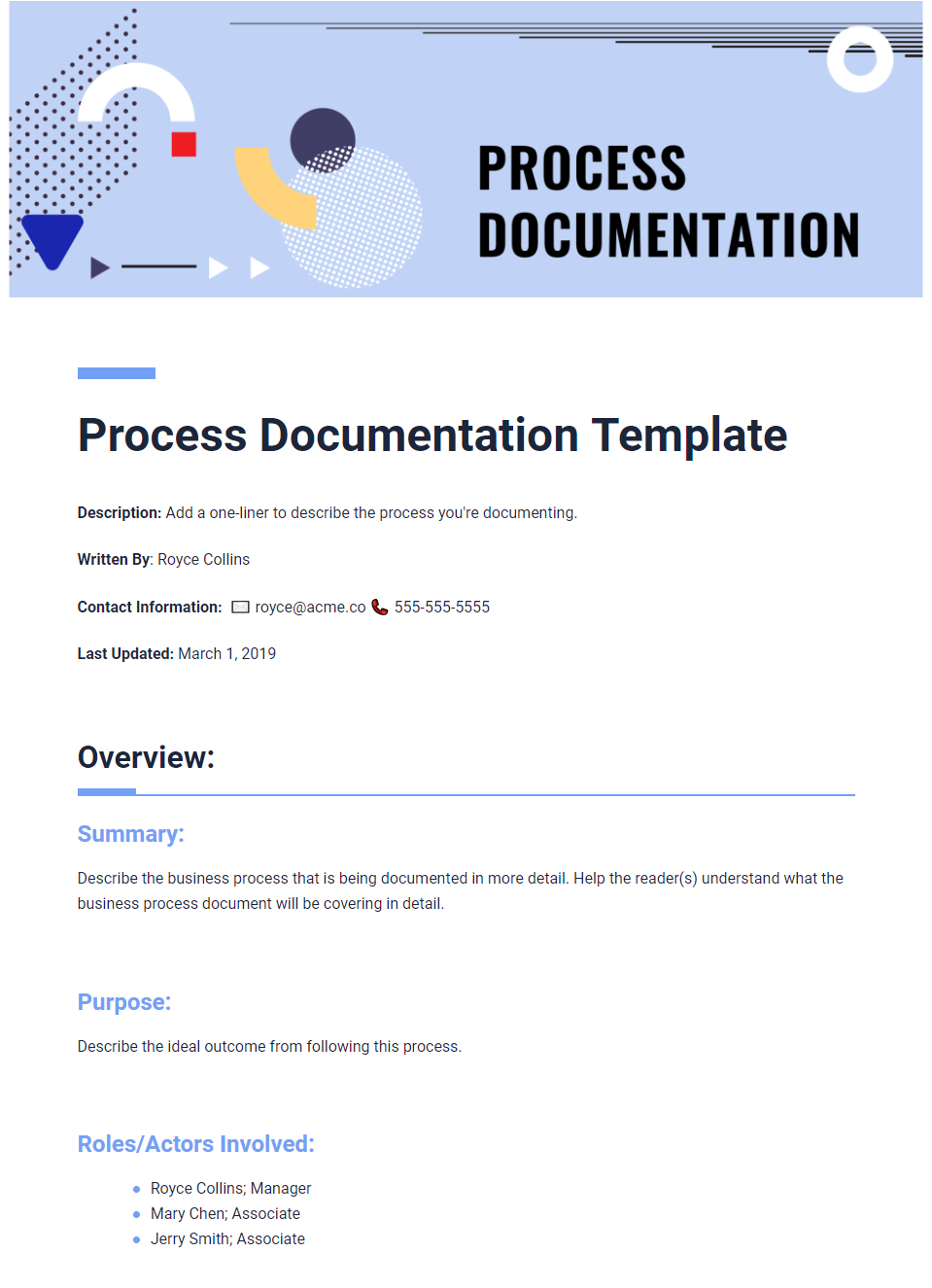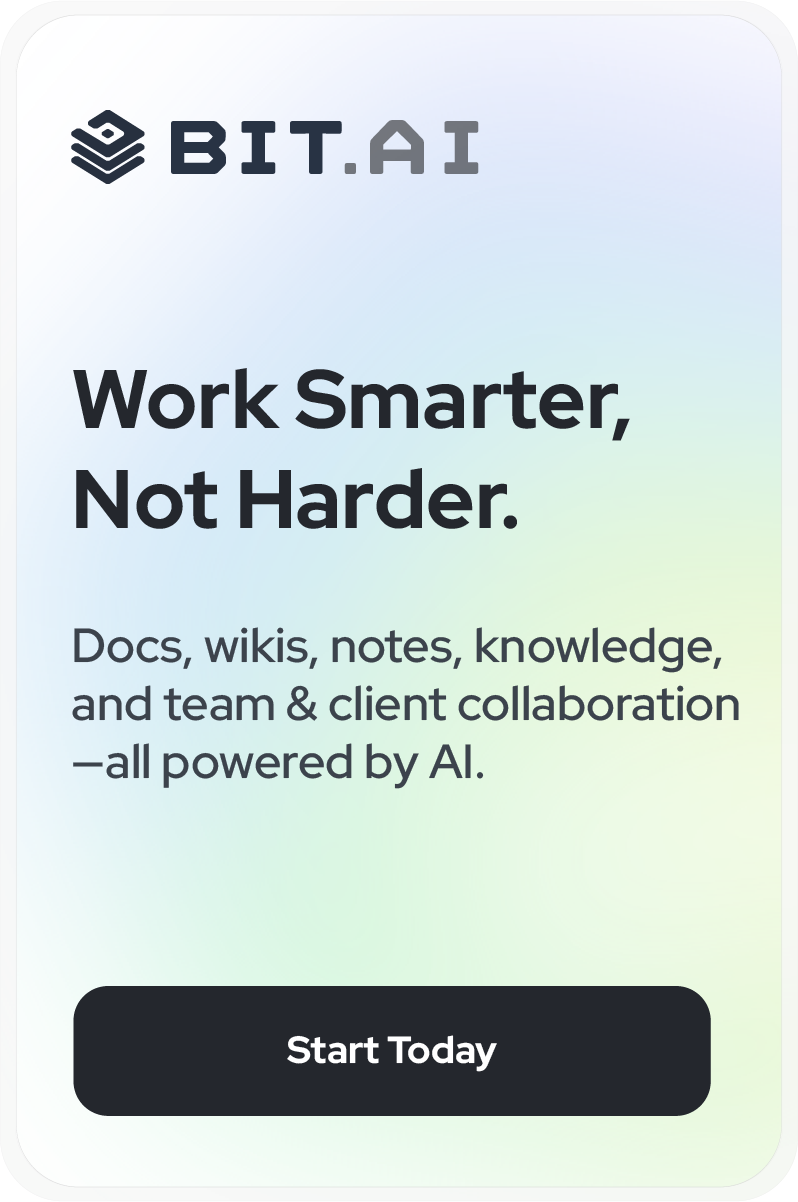What Is Process Documentation?
Process documentation is a detailed description of how to execute a process. The process document outlines the exact steps needed to complete a task or process from start to finish.
The area of process documentation triggers how employee members perform the process, and not what the process is.
Process documentation is important for any business because it enhances consistency and lets your staff learn from both their successes and their mistakes.
Benefits of Process Documentation
Process documentation helps in:
- Saving time & money
- Reducing errors
- Creating standardization
- Improving employee onboarding
- Creating workplace efficiencies
- Finding additional ways to further improve processes
- Improving workflows analytically
Process documentation is an ongoing documentation of a process while a project or task is being carried out and in no way, is the final report. It helps analyze every step of a process and provide context to improve the process.
Every organization aspires to be successful and grow with time. The only way of knowing whether the business process you are employing is good enough is to keep tabs on each and every step and analyze, get feedback and suggest changes to improve. Only then the business will be able to run at its full capacity and grow faster.
Read more: The Best Online Software Documentation Tools
Why Do You Need Process Documentation?
When it comes down to creating new processes or refining existing ones, there’s no better way to do it than to document the processes. The following are primary benefits that an organization seeks to achieve by documenting its processes:
1. Improving a Process
Most companies use repeatable business processes to get work done. People often downplay writing down steps to a process and rely on their “memory” or “guesswork” to perform tasks.
This is often the recipe for disaster. You are highly unlikely to make improvements to the process if you are unaware of:
- What business processes are taking place
- What the role of each step is in a process
- What the role of your co-workers is in the process cycle
- How the process impacts the overall bottom line of the business
To know what to do, you must know where to start.
Process documentation, thus, provides the eagle-eye view to a process and helps businesses figure out new strategies and tactics to create efficiencies in the workplace.
2. Use it as Training Material
Process documentation also acts as an essential training guide for new employees. Documentation acts as a “syllabus” for new hires and gets them up to speed with their new roles.
This saves a significant amount of time for managers who would otherwise need to explain detailed processes to new hires.
It accelerates the learning curve exponentially and provides all the resources needed to understand the workflow in one place. It helps them understand their role and how it fits into the overall organization.
Read more: How To Create An Incredible Training Manual (Template Included)
3. Reduce Operational Ambiguity
Another key reason for documenting processes is to remove any sort of ambiguity of role and responsibility in the workplace. Business process documents clearly state:
- Tasks required to complete a process
- Individual roles and responsibilities
- The person assigned to do the task
- How to perform the task
This documented methodology reduces a lot of confusion in the workplace.
Anyone can access the process document anytime as it acts as a central repository for knowledge and information for the whole organization. This type of transparency stops any sort of tension from building within teams.
4. Preserve Key Knowledge
One often overlooked benefit of process documentation is its ability to preserve vital information and knowledge.
 By making a note of each and every step, everyone in the team knows how a particular process is carried out. So when a “high profile” or a critical employee leave, he/she doesn’t take the process knowledge with them.
By making a note of each and every step, everyone in the team knows how a particular process is carried out. So when a “high profile” or a critical employee leave, he/she doesn’t take the process knowledge with them.
5. Analysis
Process documentation makes it easier for management teams to analyze and compare previous versions of a process with new ones and calculate efficiency, reduced costs, and analyze other important metrics.
It helps management find whether their efforts are reaping the results they hoped for or should they try a different approach.
The learnings from process documentation can also be replicated to other processes, which can save a lot of time and money.
Read more: How To Create A Smarter Employee Handbook
What Is The Aim Of Process Documentation?
The aim or goal of process documentation is to keep track of an ongoing process for the purpose of improving it in the future. The idea is to learn from the documentation, analyze the steps taken, and suggest changes and improvements.
Process documentation helps in:
- Improving process efficiency
- Locating flaws
- Improving process quality
- Improves the time taken to complete a process
- Reduces costs
- Provides a line of sight to employees involved
Read more: What is a Software Requirements Document
Who Are All Involved In Process Documentation?
Business process documentation involves three parties:
- The Internal team (aka project team)
- The stakeholders
- The external parties
1. The Project Team
The project team holds responsibility for process documentation. Documenting the process while performing it makes sure that the project team is conscious of their efforts and are constantly learning.
It also makes sure that none of the steps in a process goes unnoticed and is recorded properly. However, you can also hire or put a specialist on the team just for the purpose of documenting the processes.
In this way, the project team does not have to interrupt their flow from time to time to document each and every step- the specialist can take care of that from a distance.
Read more: 20 Best Online Collaboration Tools For Teams
2. The Stakeholders
A stakeholder is someone who has a direct or indirect interest in a company. A stakeholder is any person, organization, social group, or society at large.
Any stakeholders involved in a specific project should be involved in process documentation. This helps them analyze the steps taken in any process and give feedback or suggestions accordingly.
3. The External Parties
You can even involve outsiders a part of your process documentation.
This helps in getting an unbiased and fair judgment of the business practices and provides a new perspective. Observing things from a distance at times provides clarity and the ability to find more efficient ways of doing something.[/vc_column_text]
How To Create Process Documentation?
Process documentation’s complexity depends upon the scale of the process being documented. If its a shorter process, its relatively easier to document a process as it involves a smaller number of people, stakeholders and the overall number of steps.

However, if it’s a broad-scope process, involving internal as well as external stakeholders from different departments and specialties, process documentation can turn out to be fairly complex.
Therefore, we need to have certain guidelines or roadmap in place to make sure that process documentation is carried out effectively, irrespective of process size and scope.
The following are some key steps your team should incorporate while preparing for a business process documentation.
1. Scope
First and foremost, determine the scope of the process document. The scope answers questions like which process will be covered, what are the goals of the project, what changes are to be made (if any), etc.
2. Resources needed
Describe the resources that the team needs in order to complete the process you want to describe (inputs required). You also need to describe the outputs or what is being produced at the end of process documentation.
3. Know your audience
If you don’t know who your audience is and what their expectations are from the process documentation, you are wasting your time. Only when you are familiar with the audience can you create a document that meets their requirements.
4. Describe the team involved
Describe the team members involved in a process. Describe their roles and responsibility to establish clarity.
5. Collect information
Information is often collected through a brainstorming session about the steps required to complete an activity amongst the team members involved. It can also involve the views or expertise of stakeholders and outsiders.
6. Putting it all together
After you have made sure that all the steps required to perform a process from start to finish are noted, it’s time to organize them in a sequential list format.
Make sure the steps are organized in the actual manner in which they work (process) is done. Write down the steps in a clear, concise way to be useful to your co-workers. Make the process documents easy to read by using bullets, headings, tables, charts, etc.
7. Flowchart
It’s now time to visualize the list of activities for your team in terms of a flowchart. Visually representing the steps involved in a process provides an easy way for outsiders and people from other departments to understand how a process is carried out. It also aids new employees to soak in information quickly and get up to speed with the work.
Read more: 9 Amazing Flowchart Software and Tools of 2022
8. Get feedback
Share the process documentation with fellow colleagues and stakeholders and have them try to perform the process on their own.
This is a critical step in your documentation process as it helps to determine potential loopholes or corrections in the documentation by allowing outsider’s perspectives to the document.
The visual representation of the process helps team members to see the process in a different light and find out if they missed something.
9. Improve
It’s time to optimize the steps and add any improvements suggested by colleagues, stakeholders or fellow team members.
Rinse and repeat until your process is completely optimized and efficient. Keep adding changes to the document when you find a new strategy technique or tactic to improve your process.
10. Make it available
Once you are satisfied with the results, make the documentation available to relevant employees and stakeholders of the company. Ask them to freely provide their valuable suggestions and feedback.
Process Documentation Template to make life easy!
To make this procedure as easy as a breeze, we have got a well-equipped template for you! With this process documentation template, you do not have to worry about any of the do’s and don’ts, just a few simple clicks and Boom! it’s ready.

🎥Watch this video to learn more👇
Our team at bit.ai has created a few more templates to make your business processes more efficient. Make sure to check them out before you go, your team might need them!
- SWOT Analysis Template
- Business Plan Template
- Competitor Research Template
- Project Proposal Template
- Company Fact Sheet
- Operational Plan Template
Final Words And Best Practices
In today’s fast-paced digital world, productivity is the norm. Everybody wants to get ahead of the curve by doing work quickly, efficiently, with reduced costs. They want to make use of minimum resources and at the same time, maintain top-notch quality.
Process documentation thus becomes a key factor in the success of any department or an organization as a whole.
- It helps preserve process knowledge and makes sure information is not lost when a key employee leaves.
- Documentation also aids new employees in understanding their role and place in the value chain.
- Reduces ambiguity of operations.
- It provides a roadmap for project teams to make changes to a process, locate faults and shortcomings, and determine better ways to get work done.
Here are some of the best practices to keep in mind while creating and distributing process documentation-
- The process document should be stored in a central location.
- It should be easily accessible by anyone in the organization.
- It should be written in a clear and concise manner with proper formatting.
- It should be regularly updated with changes made to the processes.
- Feedback plays a crucial role in improving the process. Make sure there is no barrier to giving feedback and suggestions to improve a process. Feedback should be reviewed after a set period of time (i.e. once every six months) to make sure that other people’s opinions are being heard.
- Create individual documents for different processes to make it easy to understand and digest rather than one single document.
- Always make use of flowcharts to explain the steps taking place in a process. You can also add screenshots, graphs, charts, tables, and other graphics to make it as easy to understand as possible.
- Only make the latest document available to the public.
And that’s it, folks! What are your thoughts on process documentation? Do you consider it an essential part of a business process? Let us know in the comments below!
Further reads :
- Change Management Plan for Smooth Transition Process
- Business Documents: Definition, Types, Benefits & Steps to Create Them!
- Project Summary: What is it & How to Write it!
- Project Outline: What is it & How to Create it for Your Business?
- Action Plan: Definition, Importance & How to Steps!
- Top 5 Business Process Management (BPM) Tools
- How to Create a Strategic Process Improvement Plan?
- The Ultimate Guide To Document Management System




